Actual Application Performance
Our application benchmarks are designed to show application performance results with times being reported in seconds, with lower scores being better. While these tests will show differences between the drives it is important to understand we are no longer measuring the synthetic performance of the hard drive but how well our test platforms perform with each individual drive. The performance of a drive is an integral part of the computer platform but other factors such as memory, CPU, core logic, and even driver choice can play a major role in determining how well the drive performs in any given task.
Adobe Photoshop CS2
We utilize the WorldBench 6.0 test script that applies an extensive series of filters to the test image. CPU, memory, and chipset speed factor heavily in this particular test but we have found this test to be good for hard drive access performance as Photoshop relies heavily on its "paging file" to improve performance.
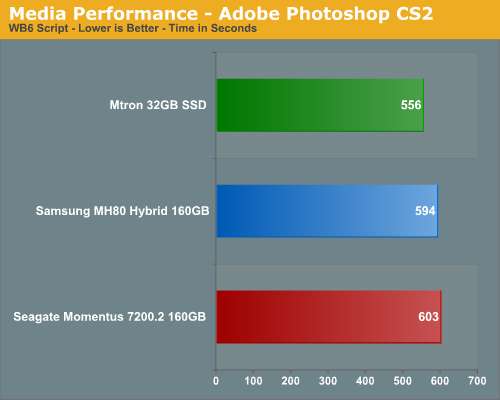
We have seen performance gaps between desktop drives, especially in RAID setups, with this particular test and there was no difference here as the MTRON SSD is about 8% faster than the other drives.
Game Level Load
The Battlefield 2 test measures the time it takes to load the Daqing Oilfields level. Our application timer begins when the start single player icon is initiated and ends when the join game icon is visible.
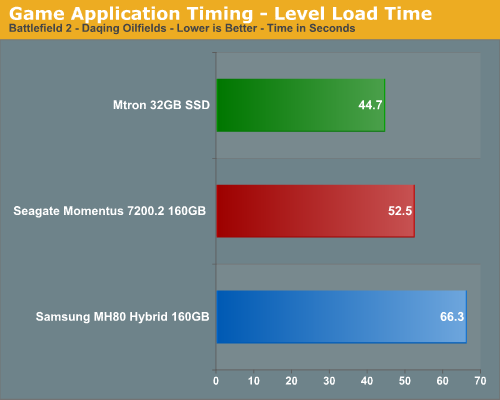
This is one of the more demanding game level load times we test currently and the MTRON drive is around 33% faster than the Samsung drive and 15% faster than the Seagate drive. We could definitely tell a difference between the drives in this test over the course of two gaming sessions. The MTRON SSD product loaded the levels in a smoother manner than our Seagate drive although it was difficult to determine any differences with the Samsung drive except when first starting the game.
Nero Recode
Our encoding test is quite easy - we fire up Nero Recode 2, select our Office Space copy on the hard drive, and perform a shrink operation to allow the entire movie along with extras to fit on a single 4.5GB DVD disc. We leave all options on their defaults except we turn off the advanced analysis option. The scores reported include the full encoding process and are represented in seconds, with lower numbers indicating better performance.
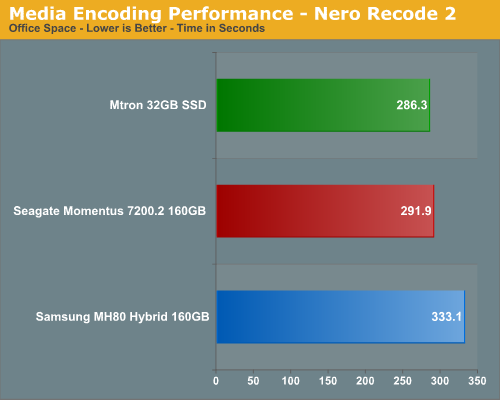
This test is primarily dependent on CPU performance but the write performance of a drive can make small but measurable differences in completion times. As in our HDTach tests, the write performance of the MTRON drive is slightly better than the Seagate and Samsung drives. Our results show the same pattern with the MTRON being 3% faster than the Seagate drive and a surprising 15% better than the Samsung drive.
We expected the NAND flash memory on the Samsung drive and Vista's ReadyDrive feature to compensate for its 5400RPM spindle speed in this test that features large sequential block sizes. The Samsung drive had the highest variation of encoding frames per second. It was an obvious buffer overflow pattern as the frames per second would start at 1100+ and as the buffer filled up the fps would sometimes drop to under 400 and then steadily increase back to the 1100 level before repeating the pattern. The other two drives held a steady fps average throughout this test with the fps variation never being more than 5%. It appears to us there is still some firmware management tuning between the two buffers that need to occur on the Samsung drive for large sequential data block sizes.
WinRAR 3.70
Our WinRAR test measures the time it takes to compress our test folder that contains 444 files, 10 folders, and 602MB of data. While the benchmark is CPU intensive for the compression tests it still requires a fast storage system to keep pace with the CPU. A drive that offers excellent write performance can make a slight difference in this benchmark.
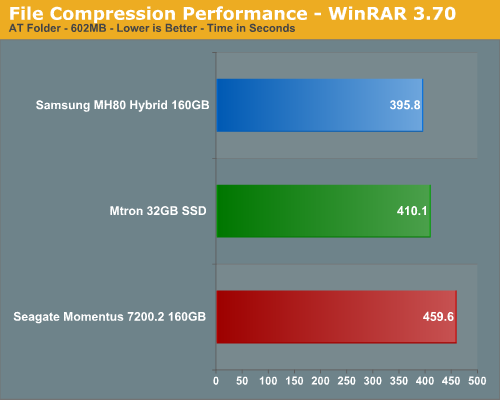
This test relies on the CPU and also the burst rates of the storage system. The Samsung drive obviously thrives on small sequential data block writes as its cache buffers more than make up for the lower spindle and higher access times. Our Samsung unit is 4% quicker than the MTRON unit and 145 better than the Seagate drive.
File Copy Performance
Our file copy test measures the time it takes to transfer our test folder that contains 29 files, 1 folder, and has 7.55GB of data from our source drive to the target test drive. This benchmark is disk write intensive and requires a fast storage system.
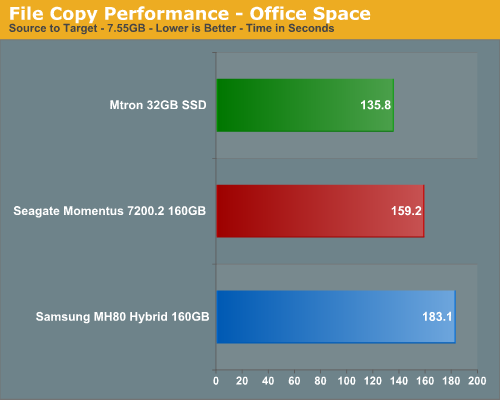
We finish our application tests with a benchmark that favors the MTRON's higher write speeds. As in Nero Recode, where the largest differences in scores were generated with large sequential data block writes, we see the Samsung drive being up to 27% slower than the MTRON drive and 14% when compared to the Seagate unit. However, we find it hard to fault the Samsung drive considering most portable users will be using applications that usually generate small sequential or out-of order data blocks. These type of read or write patterns is something the Samsung drive excels at in initial testing.
Our application benchmarks are designed to show application performance results with times being reported in seconds, with lower scores being better. While these tests will show differences between the drives it is important to understand we are no longer measuring the synthetic performance of the hard drive but how well our test platforms perform with each individual drive. The performance of a drive is an integral part of the computer platform but other factors such as memory, CPU, core logic, and even driver choice can play a major role in determining how well the drive performs in any given task.
Adobe Photoshop CS2
We utilize the WorldBench 6.0 test script that applies an extensive series of filters to the test image. CPU, memory, and chipset speed factor heavily in this particular test but we have found this test to be good for hard drive access performance as Photoshop relies heavily on its "paging file" to improve performance.

We have seen performance gaps between desktop drives, especially in RAID setups, with this particular test and there was no difference here as the MTRON SSD is about 8% faster than the other drives.
Game Level Load
The Battlefield 2 test measures the time it takes to load the Daqing Oilfields level. Our application timer begins when the start single player icon is initiated and ends when the join game icon is visible.

This is one of the more demanding game level load times we test currently and the MTRON drive is around 33% faster than the Samsung drive and 15% faster than the Seagate drive. We could definitely tell a difference between the drives in this test over the course of two gaming sessions. The MTRON SSD product loaded the levels in a smoother manner than our Seagate drive although it was difficult to determine any differences with the Samsung drive except when first starting the game.
Nero Recode
Our encoding test is quite easy - we fire up Nero Recode 2, select our Office Space copy on the hard drive, and perform a shrink operation to allow the entire movie along with extras to fit on a single 4.5GB DVD disc. We leave all options on their defaults except we turn off the advanced analysis option. The scores reported include the full encoding process and are represented in seconds, with lower numbers indicating better performance.

This test is primarily dependent on CPU performance but the write performance of a drive can make small but measurable differences in completion times. As in our HDTach tests, the write performance of the MTRON drive is slightly better than the Seagate and Samsung drives. Our results show the same pattern with the MTRON being 3% faster than the Seagate drive and a surprising 15% better than the Samsung drive.
We expected the NAND flash memory on the Samsung drive and Vista's ReadyDrive feature to compensate for its 5400RPM spindle speed in this test that features large sequential block sizes. The Samsung drive had the highest variation of encoding frames per second. It was an obvious buffer overflow pattern as the frames per second would start at 1100+ and as the buffer filled up the fps would sometimes drop to under 400 and then steadily increase back to the 1100 level before repeating the pattern. The other two drives held a steady fps average throughout this test with the fps variation never being more than 5%. It appears to us there is still some firmware management tuning between the two buffers that need to occur on the Samsung drive for large sequential data block sizes.
WinRAR 3.70
Our WinRAR test measures the time it takes to compress our test folder that contains 444 files, 10 folders, and 602MB of data. While the benchmark is CPU intensive for the compression tests it still requires a fast storage system to keep pace with the CPU. A drive that offers excellent write performance can make a slight difference in this benchmark.

This test relies on the CPU and also the burst rates of the storage system. The Samsung drive obviously thrives on small sequential data block writes as its cache buffers more than make up for the lower spindle and higher access times. Our Samsung unit is 4% quicker than the MTRON unit and 145 better than the Seagate drive.
File Copy Performance
Our file copy test measures the time it takes to transfer our test folder that contains 29 files, 1 folder, and has 7.55GB of data from our source drive to the target test drive. This benchmark is disk write intensive and requires a fast storage system.

We finish our application tests with a benchmark that favors the MTRON's higher write speeds. As in Nero Recode, where the largest differences in scores were generated with large sequential data block writes, we see the Samsung drive being up to 27% slower than the MTRON drive and 14% when compared to the Seagate unit. However, we find it hard to fault the Samsung drive considering most portable users will be using applications that usually generate small sequential or out-of order data blocks. These type of read or write patterns is something the Samsung drive excels at in initial testing.










25 Comments
View All Comments
fc1204 - Monday, August 20, 2007 - link
well, the mtron uses a fpga as it's controller. they do what companies like adtron and stec (formerly simpletech) do to market ssd to clients- price is the concern after reliability and performance are satisfied.in the next year or two, you will start seeing asic controller-based ssd's. these will be more like the sandisk prices as opposed to the mtron prices.
on a side note, for those asking raid 0 ssd's, i need to comment that it will be harder to implement this in a viable consumer application because the price is just a bit more than the benefits- power-consumption and mobile-ruggedness (people have 600+watt psu's and cases that don't bounce while in operation) and laptops are replacing desktops in homes.
pqi has a ssd that is using raiding 2 cf controllers. we can always hope that anand gets more ssd's and crack them open.
DeepThought86 - Friday, August 17, 2007 - link
C'mon, we're all waiting for the RAID 0 results with these things!Spoelie - Sunday, August 19, 2007 - link
Actually a valid point, I'm wondering about possible problems in SSDs. Without the moving parts, reliability in RAID0 might make it more viable for desktop use.Are most of the defects predictable (i.e. this cell has been written to 1000 times and shouldn't be used anymore) and partly fixable (like having a table which designates broken cells, over time the capacity would go down then but no data lost, till it is replaced)?
Xenoterranos - Friday, August 17, 2007 - link
The HDD Tach chart for the SSD made me lol. Just seeing a flat line on a HDD performance chart makes me feel all warm and fuzzy inside.Spoelie - Sunday, August 19, 2007 - link
I thought someone died :(The other lines look more heatbeaty :D
Slaimus - Friday, August 17, 2007 - link
Who are they targetting with this insane price?brundlefly - Sunday, August 19, 2007 - link
MTRON isnt even marketing this to consumers - its a product generally sold for military and industrial use where shock and heat tolerances are high.However, I ordered it for a database drive, and it is actually one of the cheapest and simplest ways to improve the performance of disk i/o bound large tables.
Spoelie - Sunday, August 19, 2007 - link
If you read the previous article, you'd know, it's not meant for desktop use due to it's extremely rugged design;"The drive is marketed into the commercial, server, and industrial sectors with an emphasis placed on performance storage needs with a high degree of tolerance to environmental conditions."
i.e. specialized systems in low volume markets, not commoditized desktop systems.
Also, the other SSD's may be cheaper, but as also mentioned in the other article;
"These specifications far exceed those of the latest SanDisk and Samsung consumer SSD products that are approaching 67MB/sec read speeds and 45MB/sec write speeds"
You always pay a price for performance.
In conclusion, these articles are more of a future outlook on storage technology, not really about something regular joe will buy in a mom 'n pop store.
AnnihilatorX - Saturday, August 18, 2007 - link
I agree. SanDisk's 32GB is just $500Axbattler - Friday, August 17, 2007 - link
What is the cost of the Seagate and Samsung? It doesn't look like the inclusion of a relatively large Flash buffer is able to fully compensate for the slower rotational speed at all time. But it does edge the Seagate in a few instance leading me to think that if the cost premium is not too high, it is not unthinkable for traditional HD to 'evolve' into hybrids in next couple of years. A hybrid version of a Raptor should be quite interesting.SSD is looking very good here, but even with significant price decrease each year, I do not see those become 'mainstream' for quite some time. Increasingly affordable for the enthusiasts (desktop), and flagship/customised high end laptop sure. But we are not going to see those in every HP/Dell desktop (or even laptop) for quite some time IMO. Then again, have other HD manufacturers (WD, Hitachi, Seagate) announced their own plans for hybrids?